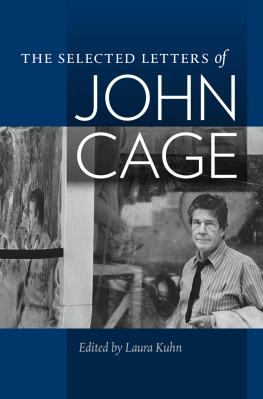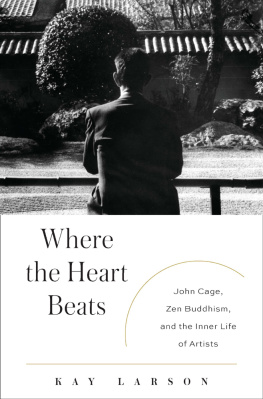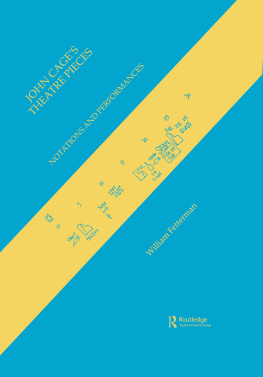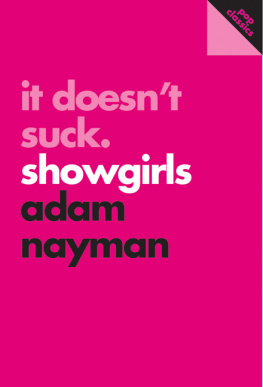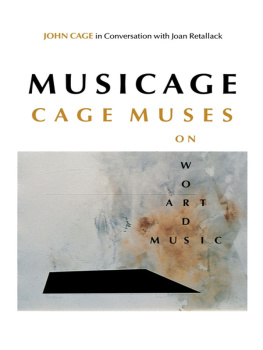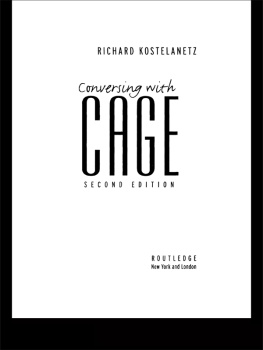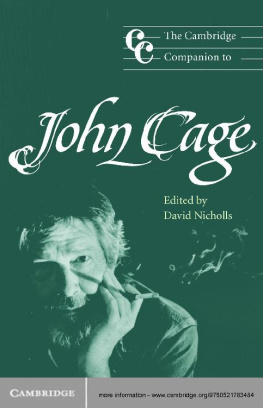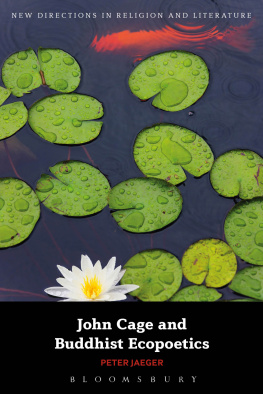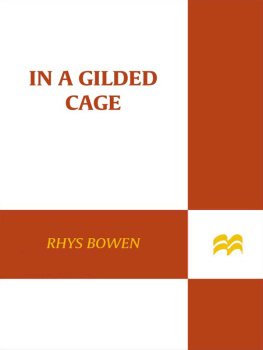Cage John - The selected letters of John Cage
Here you can read online Cage John - The selected letters of John Cage full text of the book (entire story) in english for free. Download pdf and epub, get meaning, cover and reviews about this ebook. City: Middletown, CT, year: 2016, publisher: Wesleyan University Press, genre: Home and family. Description of the work, (preface) as well as reviews are available. Best literature library LitArk.com created for fans of good reading and offers a wide selection of genres:
Romance novel
Science fiction
Adventure
Detective
Science
History
Home and family
Prose
Art
Politics
Computer
Non-fiction
Religion
Business
Children
Humor
Choose a favorite category and find really read worthwhile books. Enjoy immersion in the world of imagination, feel the emotions of the characters or learn something new for yourself, make an fascinating discovery.
- Book:The selected letters of John Cage
- Author:
- Publisher:Wesleyan University Press
- Genre:
- Year:2016
- City:Middletown, CT
- Rating:4 / 5
- Favourites:Add to favourites
- Your mark:
- 80
- 1
- 2
- 3
- 4
- 5
The selected letters of John Cage: summary, description and annotation
We offer to read an annotation, description, summary or preface (depends on what the author of the book "The selected letters of John Cage" wrote himself). If you haven't found the necessary information about the book — write in the comments, we will try to find it.
Cage John: author's other books
Who wrote The selected letters of John Cage? Find out the surname, the name of the author of the book and a list of all author's works by series.
The selected letters of John Cage — read online for free the complete book (whole text) full work
Below is the text of the book, divided by pages. System saving the place of the last page read, allows you to conveniently read the book "The selected letters of John Cage" online for free, without having to search again every time where you left off. Put a bookmark, and you can go to the page where you finished reading at any time.
Font size:
Interval:
Bookmark:

THE SELECTED LETTERS of
JOHN CAGE
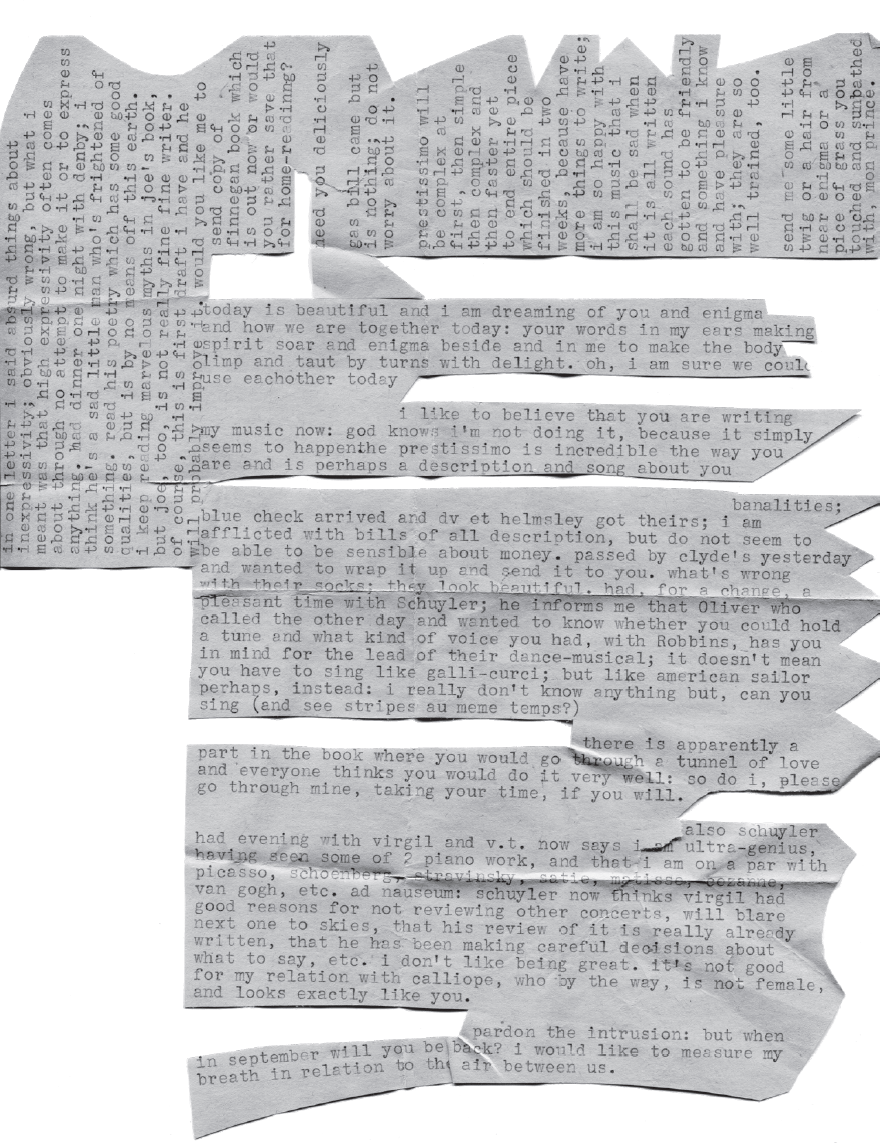
publication of this book is funded by the Beatrice Fox Auerbach Foundation Fund at the Hartford Foundation for Public Giving
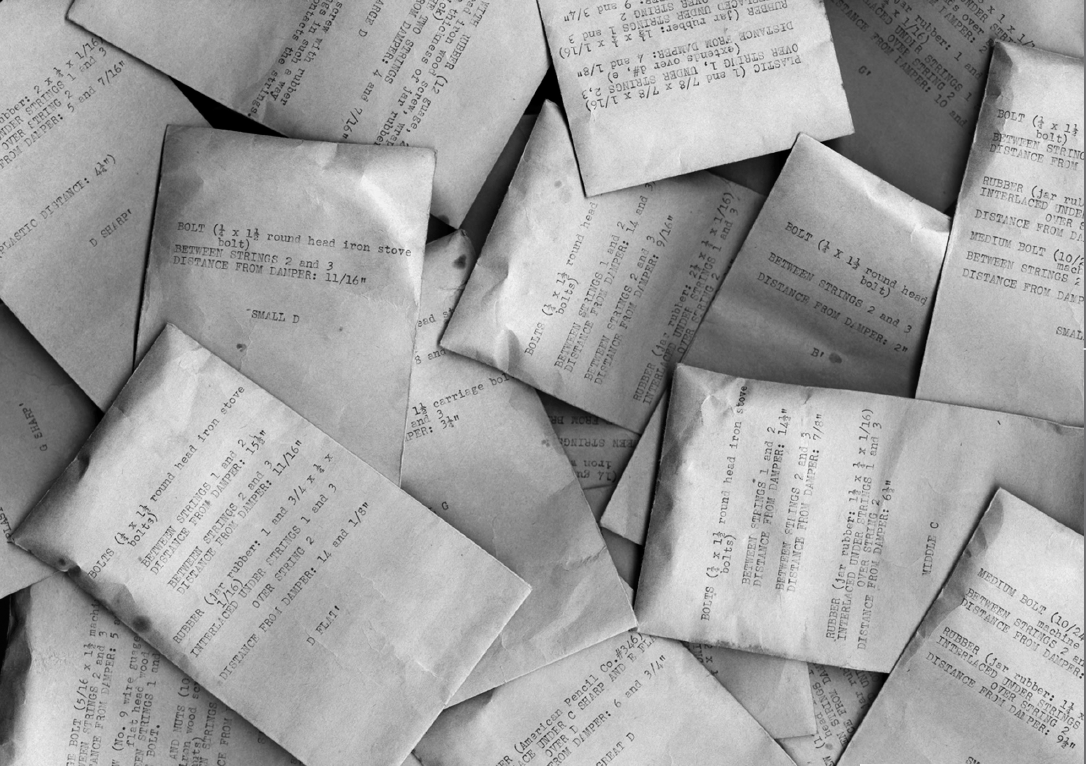
THE SELECTED LETTERS of
JOHN CAGE
Edited by Laura Kuhn
Wesleyan University Press | Middletown, Connecticut
WESLEYAN UNIVERSITY PRESS
Middletown CT 06459
www.wesleyan.edu/wespress
2016 John Cage Trust
All rights reserved
Manufactured in the United States of America
Designed by Eric M. Brooks
Typeset in Albertina by Passumpsic Publishing
publication of this book is funded by the Beatrice Fox Auerbach Foundation Fund at the Hartford Foundation for Public Giving
Library of Congress Cataloging-in-Publication Data
Names: Cage, John. | Kuhn, Laura Diane.
Title: The selected letters of John Cage / edited by Laura Kuhn.
Description: Middletown, Connecticut: Wesleyan University Press, [2016] | Includes bibliographical references and index.
Identifiers: LCCN 2015041918 |
ISBN 9780819575913 (cloth: alk. paper) |
ISBN 9780819575920 (ebook)
Subjects: LCSH: Cage, JohnCorrespondence. |
ComposersCorrespondence.
Classification: LCC ML410.C24 A4 2016 | DDC 780.92dc23
LC record available at http://lccn.loc.gov/2015041918
5 4 3 2 1
Cover photo: James Klosty. The Fondation Maeght in Saint-Paul-de-Vence (1970).
for RALPH
CONTENTS
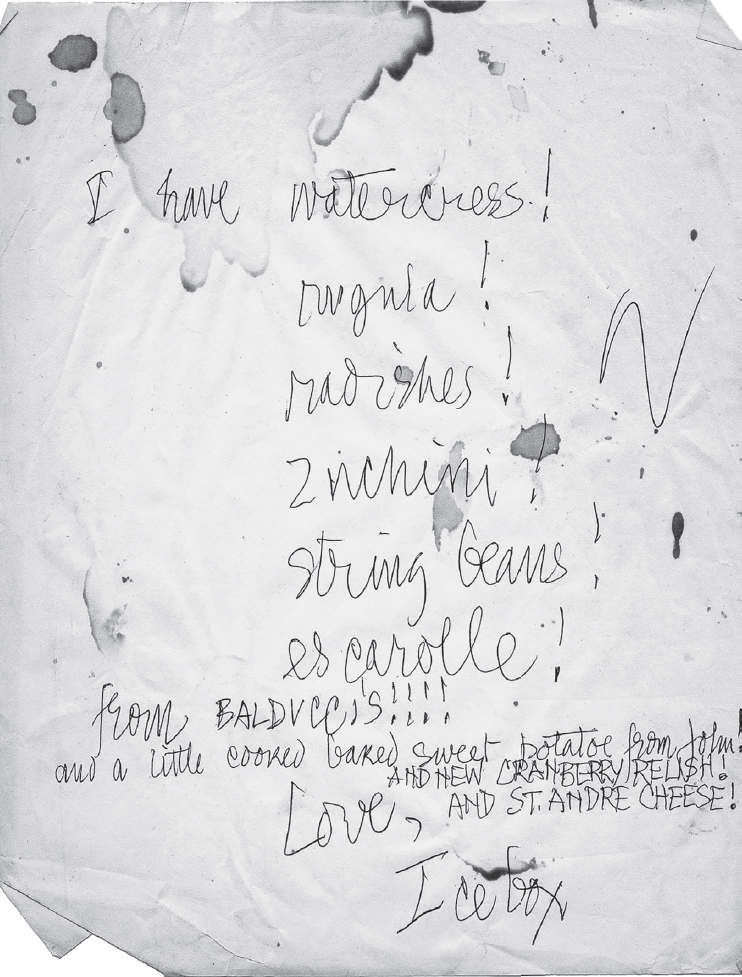
PREFACE
The first day I formally met John Cage at his 18th Street loft, in the spring of 1987, he met me at the elevator. I would later learn that he did this with all of his visitors, welcoming them into the home he had shared with Merce Cunningham for nearly a decade. He was amiable but preoccupied, and I soon learned why. It was window-washing day at the loft, and the scores of plants that lined the windowsills of the apartment had to be removed to the floor. Meanwhile, the entire apartment smelled of granola, which was baking merrily in the oven.
Cage and I proceeded to move the plantsblooming cultivars, cacti and succulents, evergreens of many kindswhile getting acquainted. Cage learned that I was near the end of a New York City residency in between two graduate degrees at UCLA, and I learned that Cage was dangerously behind on his Europeras 1 & 2, a commission from the Frankfurt Opera. Cage had taken on a Wagnerian role, assuming full charge of every aspect of the workmusic, of course, for both orchestra and singers, but also casting, lighting, costumes, stage actions and design, even the program booklet. He and Andrew Culver, his programmer/assistant, were in the thick of designing the lighting program. Invited by Cage to participate, I snagged an area yet untouched, the costumes, and, at Cages suggestion, also agreed to help wherever extra hands and eyes were needed.
In the weeks that followed, I created a database of dress drawn from documents held at the Fashion Institute of Technology. This, in time, would be subjected to chance operations for Germanys final selections. We spent a week photographing encyclopedia images, me, Andy, and Cage, the tips of my fingers captured for all of posterity in the edges of many of the original shots. From the start, Cage and I were perfect for each other. Cage didnt like telling others what to do and I didnt like to be told. But he was also deeply committed to seeing that his work became my own. I was free as I could be to populate the database, which was inspired by Cages only mandate: that the stage look something like what one might see on any corner of multicultural Manhattan. In the weeks before my return to Los Angeles, we worked together nearly every day, from the moment Merce left for his dance studio, usually by 10 a.m., until Cage would knock off, right around 5 p.m., for a game or two of chess, often with the artist Bill Anastasi. Wine was never poured before six heures, but always soon after and always red. Conversation during this closing time was as it had been throughout the day: almost always about composition and work, rarely about current events. When Cage telephoned me in California later that year to suggest I return to New York for further work together, I said yes.
The last five years of Cages life were intense. In 1987, in addition to the Frankfurt premiere of his Europeras 1 & 2, Cage oversaw a lavish production of his Roaratorio: An Irish Circus on Finnegans Wake at Londons Royal Albert Hall with the Merce Cunningham Dance Company. He began work with Henning Lohner on his film, One11 (1992), and oversaw the premiere installation of his Henry David Thoreauinspired Essay at Documenta 8 in Kassel. He also attended a grand Musicircus in honor of his seventy-fifth birthday at the Los Angeles Festival John Cage Celebration, involving hundreds of performers. In 1988 his formal engagement with watercolors began at the Mountain Lake Workshop in Virginia with Ray Kass, where he produced the first of two beautiful bodies of work, New River Watercolors. He traveled to Moscow to teach and to attend the Third International Music Festival, bunking with the Russian-born American lexicographer Nicolas Slonimsky as they traveled around the country. Cage recalled upon his return how much he had enjoyed the irregular movements of the trains.
Cage mostly spent the academic year 19881989 as the Charles Eliot Norton Professor of Poetry at Harvard University, producing six full-length mesostic poems, published by Harvard University Press as IVI, which he delivered throughout the year. In time, some of the materials used in this composition would also yield his Bolivia Mix: eighty-nine loosely bound transcripts of contemporary newspaper articleschance-determined collageswhich he distributed as a Christmas gift to friends. Why Bolivia? I asked. Because, he replied, gazing at the rocks and plants placed about, it is where I hope to retire, since no one there has any interest in modern music.
In August 1989 Cage attended the Telluride Composer-to-Composer Festival, which reconnected him with many friends, followed by travel to California, where he presented a new collaborative work at the Bay Area Radio Drama conference at the Skywalker Ranch in Nicasio. He then was in Japan to accept the prestigious Kyoto Prize, where he appeared in traditional Japanese dress to present his Autobiographical Statement as part of his acceptance speech. The check, amounting to 45 million yen (roughly $380,000), was endorsed to Merce to cover the endless shortfall of the Cunningham Dance Foundation. Cage also served as a resident composer with Pierre Boulez and Olivier Messiaen, both old friends, at the 11th Huddersfield Contemporary Music Festival in the UK. The following year, 1990, found him in Darmstadt, where he received the Schnberg Medal, in Berlin, for the Akademie der Knstes John Cage in stberlin, and in Glasgow, for the 8th Musica Nova, where he served as composer-in-residence with James MacMillan, Nigel Osborne, and Wolfgang Rihm.
In 1991, Cage received the Frederick R. Weisman Art Award for Lifetime Achievement$10,000 and a beautiful cast sculpture by Roy Lichtensteinat a candlelit ceremony in the gardens of the Los Angeles County Museum of Art. I will never forget walking up the steps to the entrance that night. Cage, in need of a haircut, dressed in traditional blue jeans, and carrying his pajamas and toothbrush in a DAgostinos grocery bag for an overnight stay in Beverly Hills, was momentarily turned away by the guard. A private affair, he muttered, blocking our way. I was horrified, but Cage was suddenly cheerful, suggesting we quickly go somewhere and have a drink before the guard changed his mind.
Next pageFont size:
Interval:
Bookmark:
Similar books «The selected letters of John Cage»
Look at similar books to The selected letters of John Cage. We have selected literature similar in name and meaning in the hope of providing readers with more options to find new, interesting, not yet read works.
Discussion, reviews of the book The selected letters of John Cage and just readers' own opinions. Leave your comments, write what you think about the work, its meaning or the main characters. Specify what exactly you liked and what you didn't like, and why you think so.

